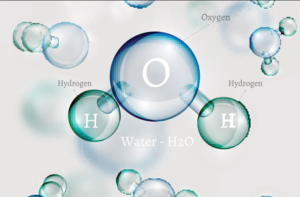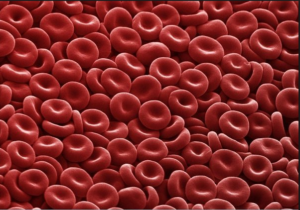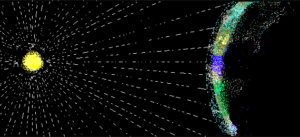Learning Outcomes
- Solve application problems involving scientific notation

Water Molecule
Solve application problems
Learning rules for exponents seems pointless without context, so let’s explore some examples of using scientific notation that involve real problems. First, let’s look at an example of how scientific notation can be used to describe real measurements.
Think About It
Match each length in the table with the appropriate number of meters described in scientific notation below.
| The height of a desk | Diameter of water molecule | Diameter of Sun at its equator |
| Distance from Earth to Neptune | Diameter of Earth at the Equator | Height of Mt. Everest (rounded) |
| Diameter of average human cell | Diameter of a large grain of sand | Distance a bullet travels in one second |
| Power of [latex]10[/latex], units in meters | Length from table above |
| [latex]10^{12}[/latex] | |
| [latex]10^{9}[/latex] | |
| [latex]10^{6}[/latex] | |
| [latex]10^{4}[/latex] | |
| [latex]10^{2}[/latex] | |
| [latex]10^{0}[/latex] | |
| [latex]10^{-3}[/latex] | |
| [latex]10^{-5}[/latex] | |
| [latex]10^{-10}[/latex] |

Red Blood Cells
One of the most important parts of solving a “real” problem is translating the words into appropriate mathematical terms, and recognizing when a well known formula may help. Here’s an example that requires you to find the density of a cell, given its mass and volume. Cells aren’t visible to the naked eye, so their measurements, as described with scientific notation, involve negative exponents.
Example
Human cells come in a wide variety of shapes and sizes. The mass of an average human cell is about [latex]2\times10^{-11}[/latex] grams[1]Red blood cells are one of the smallest types of cells[2], clocking in at a volume of approximately [latex]10^{-6}\text{ meters }^3[/latex].[3] Biologists have recently discovered how to use the density of some types of cells to indicate the presence of disorders such as sickle cell anemia or leukemia. [4] Density is calculated as the ratio of [latex]\frac{\text{ mass }}{\text{ volume }}[/latex]. Calculate the density of an average human cell.
The following video provides an example of how to find the number of operations a computer can perform in a very short amount of time.
Try It

Light traveling from the sun to the earth.
In the next example, you will use another well known formula, [latex]d=r\cdot{t}[/latex], to find how long it takes light to travel from the sun to the earth. Unlike the previous example, the distance between the earth and the sun is massive, so the numbers you will work with have positive exponents.
Example
The speed of light is [latex]3\times10^{8}\frac{\text{ meters }}{\text{ second }}[/latex]. If the sun is [latex]1.5\times10^{11}[/latex] meters from earth, how many seconds does it take for sunlight to reach the earth? Write your answer in scientific notation.
In the following video we calculate how many miles the participants of the New York marathon ran combined, and compare that to the circumference of the earth.
Summary
Scientific notation was developed to assist mathematicians, scientists, and others when expressing and working with very large and very small numbers. Scientific notation follows a very specific format in which a number is expressed as the product of a number greater than or equal to one and less than ten, and a power of [latex]10[/latex]. The format is written [latex]a\times10^{n}[/latex], where [latex]1\leq{a}<10[/latex] and n is an integer. To multiply or divide numbers in scientific notation, you can use the commutative and associative properties to group the exponential terms together and apply the rules of exponents.
Contribute!
Candela Citations
- Revision and Adaptation. Provided by: Lumen Learning. License: CC BY: Attribution
- Application of Scientific Notation - Quotient 1 (Number of Times Around the Earth). Authored by: James Sousa (Mathispower4u.com) for Lumen Learning. Located at: https://youtu.be/15tw4-v100Y. License: CC BY: Attribution
- Application of Scientific Notation - Quotient 2 (Time for Computer Operations). Authored by: James Sousa (Mathispower4u.com) for Lumen Learning. Located at: https://youtu.be/Cbm6ejEbu-o. License: CC BY: Attribution
- Screenshot: water molecule. Provided by: Lumen Learning. License: CC BY: Attribution
- Screenshot: red blood cells. Provided by: Lumen Learning. License: CC BY: Attribution
- Screenshot: light traveling from the sun to the earth. Provided by: Lumen Learning. License: CC BY: Attribution
- Unit 11: Exponents and Polynomials, from Developmental Math: An Open Program. Provided by: Monterey Institute of Technology and Education. Located at: http://nrocnetwork.org/resources/downloads/nroc-math-open-textbook-units-1-12-pdf-and-word-formats/. License: CC BY: Attribution
- Orders of magnitude (mass). (n.d.). Retrieved May 26, 2016, from https://en.wikipedia.org/wiki/Orders_of_magnitude_(mass) ↵
- How Big is a Human Cell? ↵
- How big is a human cell? - Weizmann Institute of Science. (n.d.). Retrieved May 26, 2016, from http://www.weizmann.ac.il/plants/Milo/images/humanCellSize120116Clean.pdf ↵
- Grover, W. H., Bryan, A. K., Diez-Silva, M., Suresh, S., Higgins, J. M., & Manalis, S. R. (2011). Measuring single-cell density. Proceedings of the National Academy of Sciences, 108(27), 10992-10996. doi:10.1073/pnas.1104651108 ↵